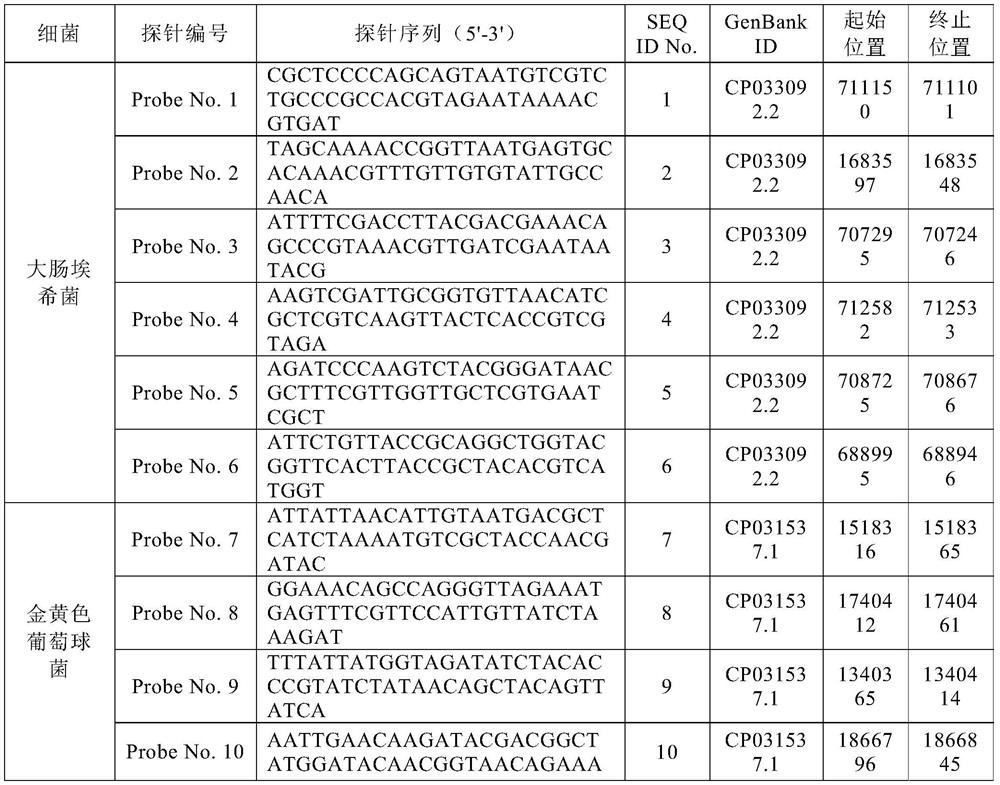Probe combination, chip, kit and method for detecting pathogenic bacteria
A kit and positive control probe technology, applied in the field of microbial detection, can solve the problems of lack of standardized processing of fluorescent signals and inability to meet the design requirements of bacterial detection gene chips, etc.
- Summary
- Abstract
- Description
- Claims
- Application Information
AI Technical Summary
Problems solved by technology
Method used
Image
Examples
Embodiment 1
[0067] Example 1 Design of specific probes for 4 kinds of food-borne pathogenic bacteria
[0068] In this embodiment, probes are designed for 4 kinds of food-borne pathogenic bacteria: Escherichia coli, Staphylococcus aureus, Listeria monocytogenes and Shigella sonnei. The specific steps are as follows:
[0069] (1) Genome database construction of four food-borne pathogenic bacteria: the reference genome sequence contained in the database is used for the construction of specific probes for four food-borne pathogenic bacteria. The inventors obtained from NCBI NT repository (ftp: / / ftp.ncbi.nlm.nih.gov / blast / db / FASTA / nt.gz), RefSeq and GenBank repository (ftp: / / ftp.ncbi.nlm.nih.gov / genomes) and other authoritative databases in the field obtained the genome sequences of 4 kinds of food-borne pathogenic bacteria. The inventors further removed redundant repetitions and genome sequences with low reliability. The removal principle is: each bacterium The upper limit of the number of ...
Embodiment 2
[0085] Embodiment 2 gene chip and its preparation
[0086] Utilize the probe gene chip of the design of embodiment 1, this gene chip also comprises control probe and global quality control probe except comprising above-mentioned probe for 4 kinds of food-borne pathogenic bacteria, and its design method is as follows:
[0087] 1. Design of control probes and global quality control probes
[0088] Negative control probe design: The inventor used computer simulation to generate 10,000 50nt artificial sequences, and used blastn to compare the sequence set to the NCBI NT library (ftp: / / ftp.ncbi.nlm.nih.gov / blast / db / FASTA / nt.gz), retaining the sequence sets with consecutively aligned bases less than 18nt and identity less than 85, and a total of 424 sequences were obtained. Randomly select a sequence as a negative control probe, in this embodiment, the selected negative control probe sequence is as follows:
[0089] Probe No.25 (SEQ ID No.25):
[0090] CAATGGCCAATTAAGATCATATCGAG...
Embodiment 3
[0109] Embodiment 3 Utilizes the gene chip to detect the sample to be tested
[0110] In this example, the inventors used the gene chip prepared in Example 2 containing 24 probes for 4 kinds of food-borne pathogenic bacteria to detect the samples to be tested. In this example, fresh fruits, vegetables, meat and poultry (often susceptible to bacterial contamination) each collected a sample (sample 1-4), the sample information is shown in Table 3:
[0111] The sample information of table 3 embodiment 3
[0112] sample name Sample category sample 1 peaches sample 2 Chinese cabbage sample 3 raw pork Sample 4 chicken
[0113] The detection specifically includes the following steps:
[0114] 1. Preparation of genomic DNA (gDNA) from the sample to be tested
[0115] The inventor used the DNA extraction kit of Agilent CGH MicroArray to extract gDNA from the sample to be tested:
[0116] (1) Nucleic acid extraction and quality inspection:...
PUM
 Login to View More
Login to View More Abstract
Description
Claims
Application Information
 Login to View More
Login to View More - R&D
- Intellectual Property
- Life Sciences
- Materials
- Tech Scout
- Unparalleled Data Quality
- Higher Quality Content
- 60% Fewer Hallucinations
Browse by: Latest US Patents, China's latest patents, Technical Efficacy Thesaurus, Application Domain, Technology Topic, Popular Technical Reports.
© 2025 PatSnap. All rights reserved.Legal|Privacy policy|Modern Slavery Act Transparency Statement|Sitemap|About US| Contact US: help@patsnap.com



